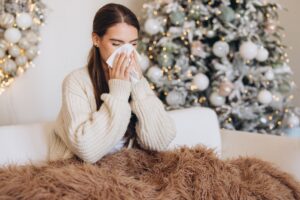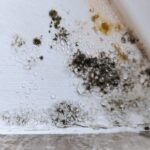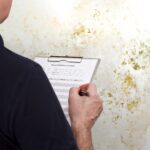Christmas Tree Syndrome and Mold

Every year, many of us look forward to setting up a Christmas tree in our homes. Whether it’s the fresh scent of pine, the sparkling lights, or the fun of decorating together, the tree is a big part of the holiday season. But while it brings beauty and holiday cheer, it can also come with some unexpected challenges, especially when it comes to something called Christmas Tree Syndrome.
One of the main culprits behind this is mold. Both real and artificial trees can carry mold, which can cause symptoms like sneezing, coughing, itchy skin, or even asthma problems. By understanding how mold grows on Christmas trees and how it affects your health, you can take simple steps to enjoy the holidays without any allergy troubles. In this blog, we’ll explore what Christmas Tree Syndrome is, how mold plays a role, and how you can have a festive and allergy free season.

What is Christmas Tree Syndrome?
Christmas Tree Syndrome is a condition that can cause allergic reactions and breathing problems due to mold, dust, and other allergens found on Christmas trees and their decorations. Whether you have a real tree or an artificial one, the holiday cheer it brings can sometimes be interrupted by sneezing, coughing, or skin irritation. The main culprits are mold growing on the tree, dust on the decorations, and bacteria that build up over time. These allergens can trigger reactions, especially for people with asthma or seasonal allergies.
Common Symptoms of Christmas Tree Syndrome
The symptoms of Christmas Tree Syndrome can vary depending on how sensitive someone is to allergens. Here are some common signs to look out for:
- Breathing issues: Sneezing, coughing, nasal congestion, or wheezing. If you’re reaching for tissues or nasal spray more often than usual, it could be because of the allergens in your tree.
- Skin irritation: Itchy skin, rashes, or eczema outbreaks can happen, especially if you come into contact with mold or dust on the tree or decorations.
- Asthma symptoms: For those with asthma, exposure to mold or other allergens may worsen their condition.
- Eye irritation: Red, itchy, or watery eyes can also be triggered by dust or mold spores.
Christmas Trees and Mold
Christmas trees are made from softwood, which naturally holds moisture. When these trees are brought into warm homes, the moisture combined with slow decay can create a perfect environment for mold to grow. The packing and storage of the trees during cutting and shipping also adds to the moisture and mold risk.
In a 2007 study presented at The American College of Allergy, Asthma & Immunology Annual Meeting, researchers tested how mold on Christmas trees affects indoor air quality. They measured mold levels in a room with a live tree over two weeks. The tree was placed 10 feet from a heat vent, and the room temperature was kept between 65-68°F.
During the first three days, the mold spore count was within the normal range at 800 spores per square meter. However, by day 14, after the tree was removed, the spore count had risen dramatically to 5,000 spores per square meter.
Dr. Lawrence Kurlandsky, an allergy specialist at Upstate Medical University in New York, studied mold in homes with Christmas trees as well. His research found 53 types of mold, including aspergillus, penicillium, cladosporium, and alternaria, which may explain the increase in respiratory issues around the holiday season.
Signs of Mold on a Christmas Tree
Mold on your Christmas tree can be hard to notice at first, but there are a few things you can look for. Catching these signs early can help prevent any health problems and keep your holiday season worry free.
Check the tree for these visual clues
- Black Spots: Small dark patches or black spots on the needles, branches, or trunk may be mold or mildew.
- Fuzzy Growth: Mold often appears as fuzzy white or grayish patches. If you see this on the tree, it’s likely mold.
- Discolored Needles: Mold can cause the needles to turn yellow or brown, especially if the tree hasn’t been watered properly or has too much moisture.
Smell
If your tree smells musty or damp, it could be a sign of mold. Mold grows in wet conditions and gives off a strong, earthy smell. If your tree doesn’t smell fresh like pine, it might be time to check for mold.
Health Problems from Mold
Mold spores can cause health issues, especially for people who are sensitive to it. Watch out for these symptoms:
- Sneezing or Coughing: Mold spores spread through the air and can trigger sneezing or coughing.
- Itchy Eyes: Mold can make your eyes feel itchy and watery, which is common for people with allergies.
- Skin Irritation: Touching moldy branches or decorations can cause rashes or itching.
- Breathing Issues: For people with asthma or respiratory conditions, mold can make breathing difficult, leading to shortness of breath or wheezing.
If you notice any of these symptoms after bringing the tree into your home, it’s a good idea to check for mold and take care of the issue right away.
Why Mold Appears on Christmas Trees
Moisture
Moisture is one of the biggest reasons mold grows on real Christmas trees. These trees naturally absorb water, and if they aren’t watered correctly or are kept in a humid environment, they can easily become a breeding ground for mold. If extra water sits at the base of the tree or on its branches, it creates a perfect spot for mold to grow.
Improper Storage
Christmas trees are usually cut weeks before they make it to your home. If they’re stored improperly before being sold, mold can start to grow. Trees stored in damp places like sheds, garages, or basements are more likely to absorb moisture, which can lead to mold. Without proper protection during storage, mold might even appear before the tree is brought inside.
Damp Environments
If your home is damp or has high humidity, it’s easier for mold to grow on your Christmas tree. This is especially true in areas with poor ventilation, like basements or bathrooms. When there’s no proper airflow, moisture gets trapped, which helps mold thrive on the tree.
Tree Transport
Mold can even show up during transport. When trees are moved from farms to stores, and then to your home, they may be exposed to rain or humid conditions. Mold spores can already be on the tree before it even makes it to your house. Once inside, the warm air can help those spores spread.
5 Simple Ways to Keep Your Christmas Tree Mold Free
Keeping your Christmas tree mold-free is important for a healthy and festive holiday. Whether you have a real or artificial tree, there are a few easy steps you can take to prevent mold from growing. Here are five simple ways to keep your tree mold free:
Pick the Right Tree
The type of tree you choose plays a big role in preventing mold.
- Artificial Trees: If you’re worried about mold, an artificial tree could be a better choice. These trees don’t grow mold like real trees, but they can gather dust if not cleaned regularly. Be sure to store it in a dry, cool place to avoid any mold issues.
- Fresh Real Trees: If you prefer a real tree, make sure it’s freshly cut, ideally within the last week or two. Choose a tree that has been stored in a dry place before coming into your home. A fresh, well-kept tree is less likely to develop mold.
Taking Good Care of Your Tree
Proper care is key to keeping your tree mold-free.
- Watering Real Trees: If you have a real tree, water it regularly, but don’t overdo it. Standing water under the tree can create the perfect environment for mold. Keep the trees standing full of water but make sure it doesn’t overflow and wet the branches. Check the water level daily, as real trees drink a lot.
- Avoid Excess Moisture: Try not to let water sit on the branches for long periods of time, as this can encourage mold. Wipe off any excess water after watering your tree.
Make Sure the Room is Well-Ventilated
Good air circulation helps prevent mold growth.
- Open Windows: If the weather allows, open windows to let fresh air in. If it’s too cold outside, using a fan or air purifier can help keep the air moving indoors.
- Control Humidity: Using a dehumidifier can help maintain a healthy indoor humidity level. Keeping the humidity between 30-50% will make it harder for mold to grow.
Store Decorations the Right Way
Mold can also grow on decorations if they’re stored improperly.
- Clean Decorations: Before putting away your decorations, make sure to clean them. Wipe down ornaments, lights, and tinsel to remove dust and mold spores. If you have fabric decorations like tree skirts, wash them before storing.
- Store in a Dry Place: Make sure to store your decorations in a cool, dry place. Avoid basements or attics, which can be damp and encourage mold growth. Airtight storage bins work best to keep out moisture and dust.
Inspect Your Tree Regularly
After your tree is up, check it often for any signs of mold. Look for dark spots, fuzzy growth, or a musty smell. If you notice any of these signs, address the issue quickly to stop it from spreading.
How to Enjoy a Mold Free Christmas Tree
As we get excited about the warmth and joy of having a Christmas tree, it’s important to keep in mind the risks mold can bring. Mold can cause health problems, especially for those with allergies or asthma, and it can take away from the holiday cheer.
To avoid mold, choose a healthy tree, take good care of it, make sure your home is well-ventilated, and store your decorations properly. With just a little extra attention, you can enjoy your Christmas tree without worrying about mold.
This holiday season, as you decorate and bring your tree indoors, keep these simple tips in mind for a healthy, happy, mold free home. Wishing you a joyful holiday full of cheer and great memories!
FAQs
Can mold grow on artificial Christmas trees?
Yes, mold can grow on artificial trees, though it’s less common than with real trees. If your tree is stored in a damp spot, it could pick up dust and moisture, which can lead to mold. To prevent this, store the tree in a dry area and clean it before setting it up each year.
How can I tell if my tree has mold?
Look for signs like black spots, fuzzy patches, or yellowing needles on a real tree. For artificial trees, mold can show up as a musty smell or visible growth on the branches. If it smells damp or musty, it might be mold.
What’s the best way to prevent mold on a real tree?
To keep mold away, water the tree properly but don’t let excess water sit at the base. Also, pay attention to the room’s humidity levels. Using a dehumidifier or making sure there’s good airflow can help keep mold from growing.
Should I throw my tree away if I find mold?
If you find mold, it’s important to act quickly. For real trees, trim the affected branches and clean off any visible mold. If the mold is widespread or causing health problems, it’s best to remove the tree. Artificial trees can usually be cleaned with a gentle wash and stored in a way that prevents future mold.
Can mold on a Christmas tree affect my health?
Yes, mold can trigger allergies or make asthma symptoms worse. Sneezing, coughing, itchy eyes, or trouble breathing can all be signs of mold exposure. If you have allergies or respiratory issues, it’s important to catch mold early and address it.
What’s the best way to store my tree decorations to avoid mold?
Store decorations in a dry, cool spot, away from damp areas like basements or attics. Use airtight containers to keep moisture and dust out. Make sure to clean the ornaments before storing them to remove any mold spores.
Can Christmas Tree Syndrome affect pets?
Yes, pets can be affected by mold from a Christmas tree, especially if they have allergies or respiratory issues. Keep an eye on your pets for symptoms like sneezing, coughing, or itchy skin while the tree is up. Keeping the tree in a well-ventilated area can help reduce the risk for both pets and people.
How do I clean mold off my real Christmas tree?
If you spot mold on your real tree, carefully remove any affected branches and wipe down the moldy spots with a damp cloth. You can use a mild soap solution or a mix of water and vinegar to clean the tree, but avoid soaking the branches. After cleaning, let the tree dry with plenty of airflow.
Can I use air fresheners to mask the smell of mold?
Air fresheners might cover up the musty smell, but they won’t get rid of the mold. It’s important to clean the tree and improve ventilation. An air purifier can help remove mold spores from the air and improve indoor air quality.
Are there any natural ways to prevent mold on my Christmas tree?
Yes, essential oils like tea tree oil or eucalyptus oil can help. Mix a small amount of oil with water and lightly mist the tree. These oils have antifungal properties that can help keep mold away. Just make sure to test it on a small area first, and avoid over-wetting the tree.










